Thermal Fluxes and Solar Energy Storage in a Massive Brick Wall in Natural Conditions
Abstract
:1. Introduction
2. Materials and Methods
3. Results
3.1. External Conditions
3.2. Energy Balance of the Wall
3.3. Recorded Temperatures
3.4. Data Fitting by Nonlinear Regression
3.5. Heat Fluxes between Layers
3.6. Solar Energy Absorption
3.7. Heat Transfer Coefficient on External Surface
4. Discussion
Funding
Data Availability Statement
Conflicts of Interest
References
- Foucquier, A.; Robert, S.; Suard, F.; Stéphan, L.; Jay, A. State of the Art in Building Modelling and Energy Performances Prediction: A Review. Renew. Sustain. Energy Rev. 2013, 23, 272–288. [Google Scholar] [CrossRef] [Green Version]
- PN-EN ISO 52016-1. Energy Performance of Buildings—Energy Needs for Heating and Cooling, Internal Temperatures and Sensible and Latent Heat Loads—Part 1: Calculation Procedures; ISO: Geneva, Switzerland, 2017. [Google Scholar]
- PN-EN ISO 13786. Thermal Performance of Building Components—Dynamic Thermal Characteristics—Calculation Methods; ISO: Geneva, Switzerland, 2007. [Google Scholar]
- De Lieto Vollaro, R.; Guattari, C.; Evangelisti, L.; Battista, G.; Carnielo, E.; Gori, P. Building Energy Performance Analysis: A Case Study. Energy Build. 2015, 87, 87–94. [Google Scholar] [CrossRef]
- Matiasovsky, P. Daily Characteristics of Air Temperature and Solar Irradiation-Input Data for Modelling of Thermal Behaviour of Buildings. Atmos. Environ. 1996, 30, 537–542. [Google Scholar] [CrossRef]
- Marino, B.M.; Muñoz, N.; Thomas, L.P. Calculation of the External Surface Temperature of a Multi-Layer Wall Considering Solar Radiation Effects. Energy Build. 2018, 174, 452–463. [Google Scholar] [CrossRef]
- Kontoleon, K.J.; Bikas, D.K. The Effect of South Wall’s Outdoor Absorption Coefficient on Time Lag, Decrement Factor and Temperature Variations. Energy Build. 2007, 39, 1011–1018. [Google Scholar] [CrossRef]
- Tsilingiris, P.T. On the Transient Thermal Behaviour of Structural Walls—the Combined Effect of Time Varying Solar Radiation and Ambient Temperature. Renew. Energy 2002, 27, 319–336. [Google Scholar] [CrossRef]
- Dornelles, K.; Roriz, V.; Roriz, M. Determination of the Solar Absorptance of Opaque Surfaces. In Proceedings of the 24th International Conference on Passive and Low Energy Architecture, Singapore, 22–24 November 2007. [Google Scholar] [CrossRef]
- Berry, R.; Livesley, S.J.; Aye, L. Tree Canopy Shade Impacts on Solar Irradiance Received by Building Walls and Their Surface Temperature. Build. Environ. 2013, 69, 91–100. [Google Scholar] [CrossRef]
- Becherini, F.; Lucchi, E.; Gandini, A.; Barrasa, M.C.; Troi, A.; Roberti, F.; Sachini, M.; Di Tuccio, M.C.; Arrieta, L.G.; Pockelé, L.; et al. Characterization and Thermal Performance Evaluation of Infrared Reflective Coatings Compatible with Historic Buildings. Build. Environ. 2018, 134, 35–46. [Google Scholar] [CrossRef]
- Wardziak, Ł.; Jaworski, M. Computer Simulations of Heat Transfer in a Building Integrated Heat Storage Unit Made of PCM Composite. Therm. Sci. Eng. Prog. 2017, 2, 109–118. [Google Scholar] [CrossRef]
- Kočí, J.; Fořt, J.; Černý, R. Energy Efficiency of Latent Heat Storage Systems in Residential Buildings: Coupled Effects of Wall Assembly and Climatic Conditions. Renew. Sustain. Energy Rev. 2020, 132, 110097. [Google Scholar] [CrossRef]
- Viegas, G.M.; Jodra, J.I.; San Juan, G.A.; Díscoli, C.A. Heat Storage Wall Made of Concrete and Encapsulated Water Applied to Mass Construction Social Housing in Temperate Climates. Energy Build. 2018, 159, 346–356. [Google Scholar] [CrossRef] [Green Version]
- Anil Kumar, Y.; Dasha Kumar, K.; Kim, H.-J. Reagents assisted ZnCo2O4 nanomaterial for supercapacitor application. Electrochim. Acta 2020, 330, 135261. [Google Scholar] [CrossRef]
- Kumar, Y.A.; Sambasivam, S.; Hira, S.A.; Zeb, K.; Uddin, W.; Krishna, T.N.V.; Kumara, K.D.; Obaidatb, I.M.; Kima, H.-J. Boosting the energy density of highly efficient flexible hybrid supercapacitors via selective integration of hierarchical nanostructured energy materials. Electrochim. Acta 2020, 364, 137318. [Google Scholar] [CrossRef]
- Anil Kumar, Y.; Dasha Kumar, K.; Kim, H.-J. Facile preparation of a highly efficient NiZn2O4–NiO nanoflower composite grown on Ni foam as an advanced battery-type electrode material for high-performance electrochemical supercapacitors. Dalton Trans. 2020, 49, 3622–3629. [Google Scholar] [CrossRef]
- Yoon, J.H.; Kumar, Y.A.; Sambasivam, S.; Hira, S.A.; Krishna TN, V.; Zeb, K.; Uddine, W.; Kumara, K.D.; Obaidatb, I.M.; Kim, S.; et al. Highly efficient copper-cobalt sulfide nano-reeds array with simplistic fabrication strategy for battery-type supercapacitors. J. Energy Storage 2020, 32, 101988. [Google Scholar] [CrossRef]
- Owczarek, M. Parametric Study of the Method for Determining the Thermal Diffusivity of Building Walls by Measuring the Temperature Profile. Energy Build. 2019, 203, 109426. [Google Scholar] [CrossRef]
- Owczarek, M.; Baryłka, A. Estimation of Thermal Diffusivity of Building Elements Based on Temperature Measurement for Periodically Changing Boundary Conditions. Rynek Energii 2019, 5, 76–79. [Google Scholar]
- Owczarek, M.; Owczarek, S.; Baryłka, A.; Grzebielec, A. Measurement Method of Thermal Diffusivity of the Building Wall for Summer and Winter Seasons in Poland. Energies 2021, 14, 3836. [Google Scholar] [CrossRef]
- Azhary, K.E.; Raefat, S.; Laaroussi, N.; Garoum, M. Energy Performance and Thermal Proprieties of Three Types of Unfired Clay Bricks. Energy Proced. 2018, 147, 495–502. [Google Scholar] [CrossRef]
- Sassine, E.; Younsi, Z.; Cherif, Y.; Chauchois, A.; Antczak, E. Experimental Determination of Thermal Properties of Brick Wall for Existing Construction in the North of France. J. Build. Eng. 2017, 14, 15–23. [Google Scholar] [CrossRef]
- Gourav, K.; Balaji, N.C.; Venkatarama Reddy, B.V.; Mani, M. Studies into Structural and Thermal Properties of Building Envelope Materials. Energy Proced. 2017, 122, 104–108. [Google Scholar] [CrossRef]
- Marrocchino, E.; Zanelli, C.; Guarini, G.; Dondi, M. Recycling Mining and Construction Wastes as Temper in Clay Bricks. Appl. Clay Sci. 2021, 209, 106152. [Google Scholar] [CrossRef]
- Akbari, H.; Kurn, D.M.; Bretz, S.E.; Hanford, J.W. Peak Power and Cooling Energy Savings of Shade Trees. Energy Build. 1997, 25, 139–148. [Google Scholar] [CrossRef] [Green Version]
- Simpson, J.R.; McPherson, E.G. Simulation of Tree Shade Impacts on Residential Energy Use for Space Conditioning in Sacramento. Atmos. Environ. 1998, 32, 69–74. [Google Scholar] [CrossRef]
- Antonopoulos, K.A.; Vrachopoulos, M. On the Inverse Transient Heat-Transfer Problem in Structural Elements Exposed to Solar Radiation. Renew. Energy 1995, 6, 381–397. [Google Scholar] [CrossRef]
- Catalina, T.; Virgone, J.; Blanco, E. Development and Validation of Regression Models to Predict Monthly Heating Demand for Residential Buildings. Energy Build. 2008, 40, 1825–1832. [Google Scholar] [CrossRef]
- Internetowa Stacja Meteo Warszawa. Available online: https://www.meteo.waw.pl/ (accessed on 23 September 2021).
- Kong, Q.; He, X.; Cao, Y.; Sun, Y.; Chen, K.; Feng, J. Numerical Analysis of the Dynamic Heat Transfer through an External Wall under Different Outside Temperatures. Energy Procedia 2017, 105, 2818–2824. [Google Scholar] [CrossRef]
- Thomas, L.P.; Marino, B.M.; Muñoz, N. Steady-State and Time-Dependent Heat Fluxes through Building Envelope Walls: A Quantitative Analysis to Determine Their Relative Significance All Year Round. J. Build. Eng. 2020, 29, 101122. [Google Scholar] [CrossRef]
- Dhifaoui, B.; Ben Jabrallah, S.; Belghith, A.; Corriou, J.P. Experimental Study of the Dynamic Behaviour of a Porous Medium Submitted to a Wall Heat Flux in View of Thermal Energy Storage by Sensible Heat. Int. J. Sci. 2007, 46, 1056–1063. [Google Scholar] [CrossRef]
- Jayamaha, S.; Wijeysundera, N.; Chou, S. Measurement of the heat transfer coefficient for walls. Build. Environ. 1996, 31, 399–407. [Google Scholar] [CrossRef]
- Li, H.; Zhong, K.; Yu, J.; Kang, Y.; Zhai, Z. Solar Energy Absorption Effect of Buildings in Hot Summer and Cold Winter Climate Zone, China. Sol. Energy 2020, 198, 519–528. [Google Scholar] [CrossRef]
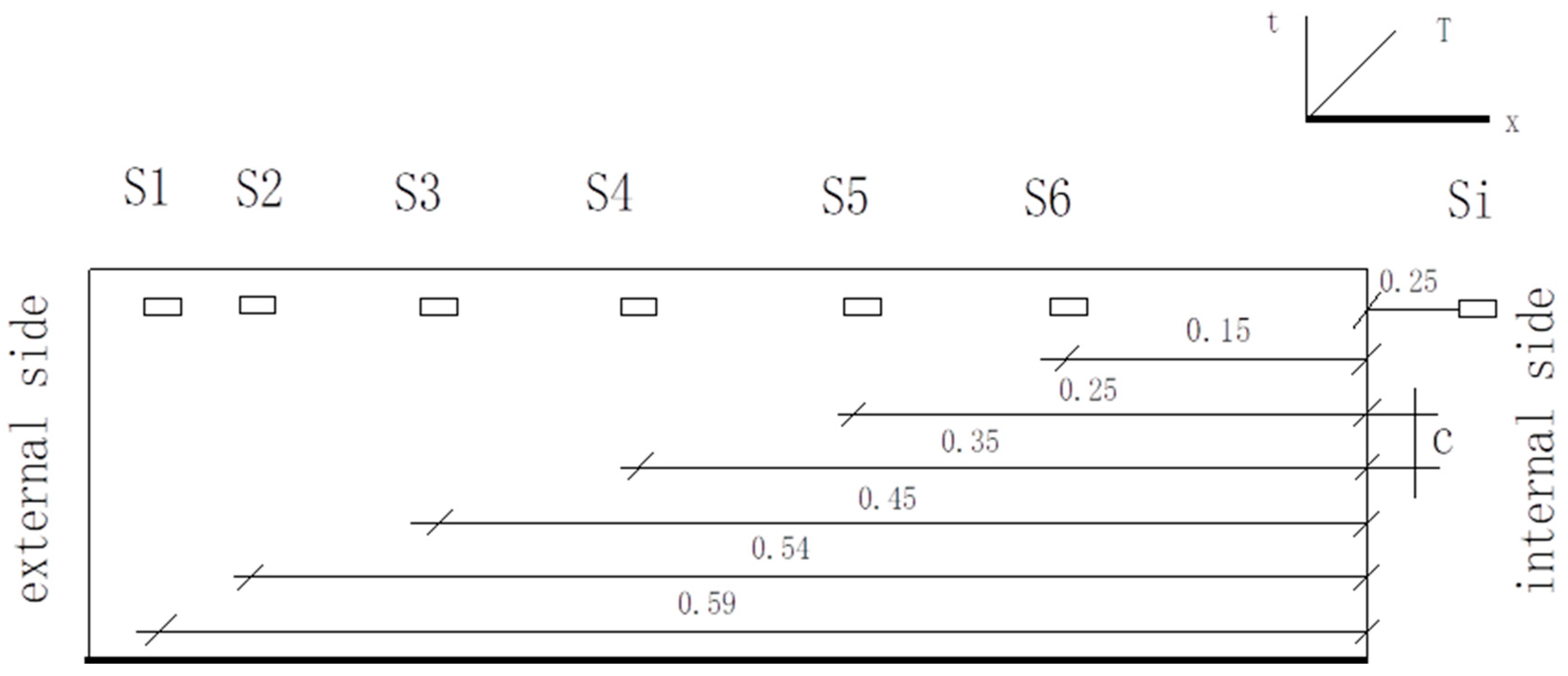
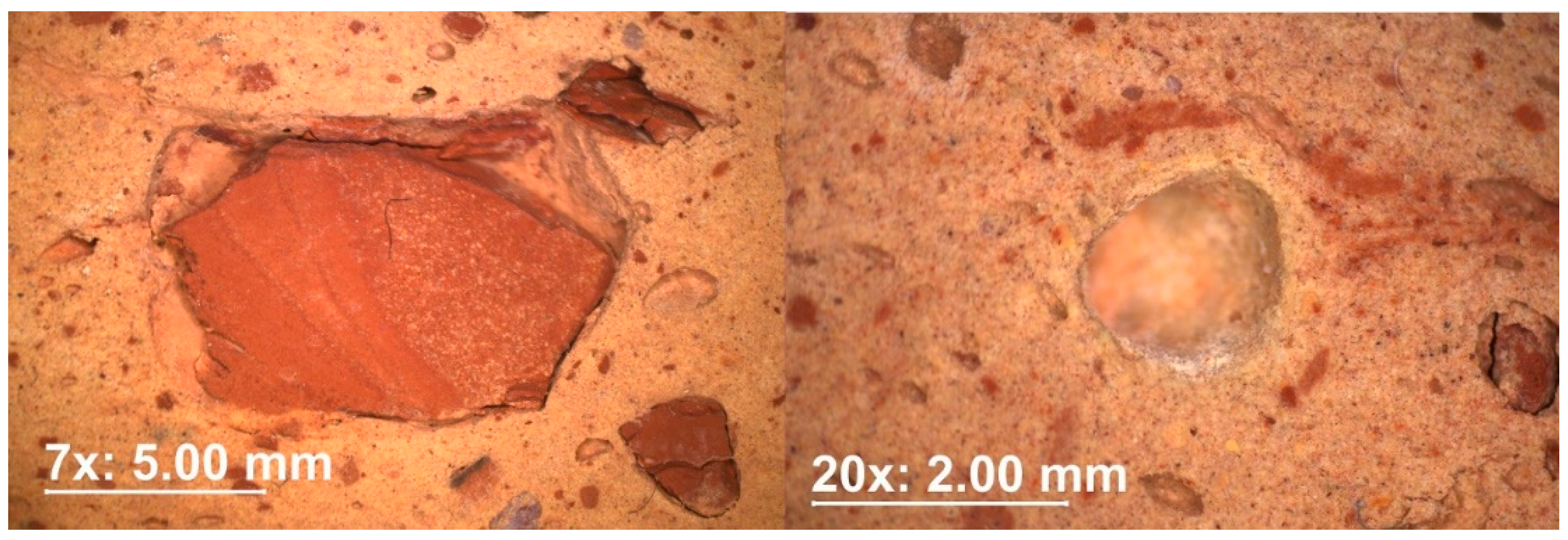
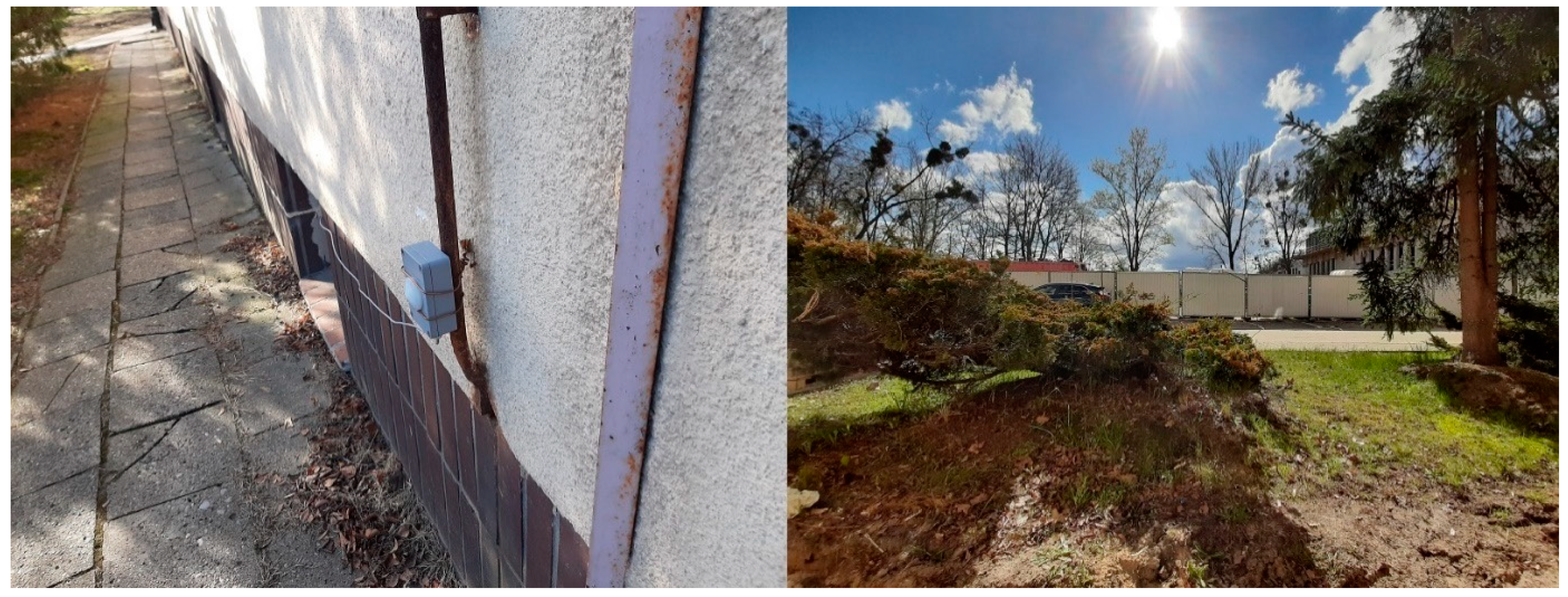
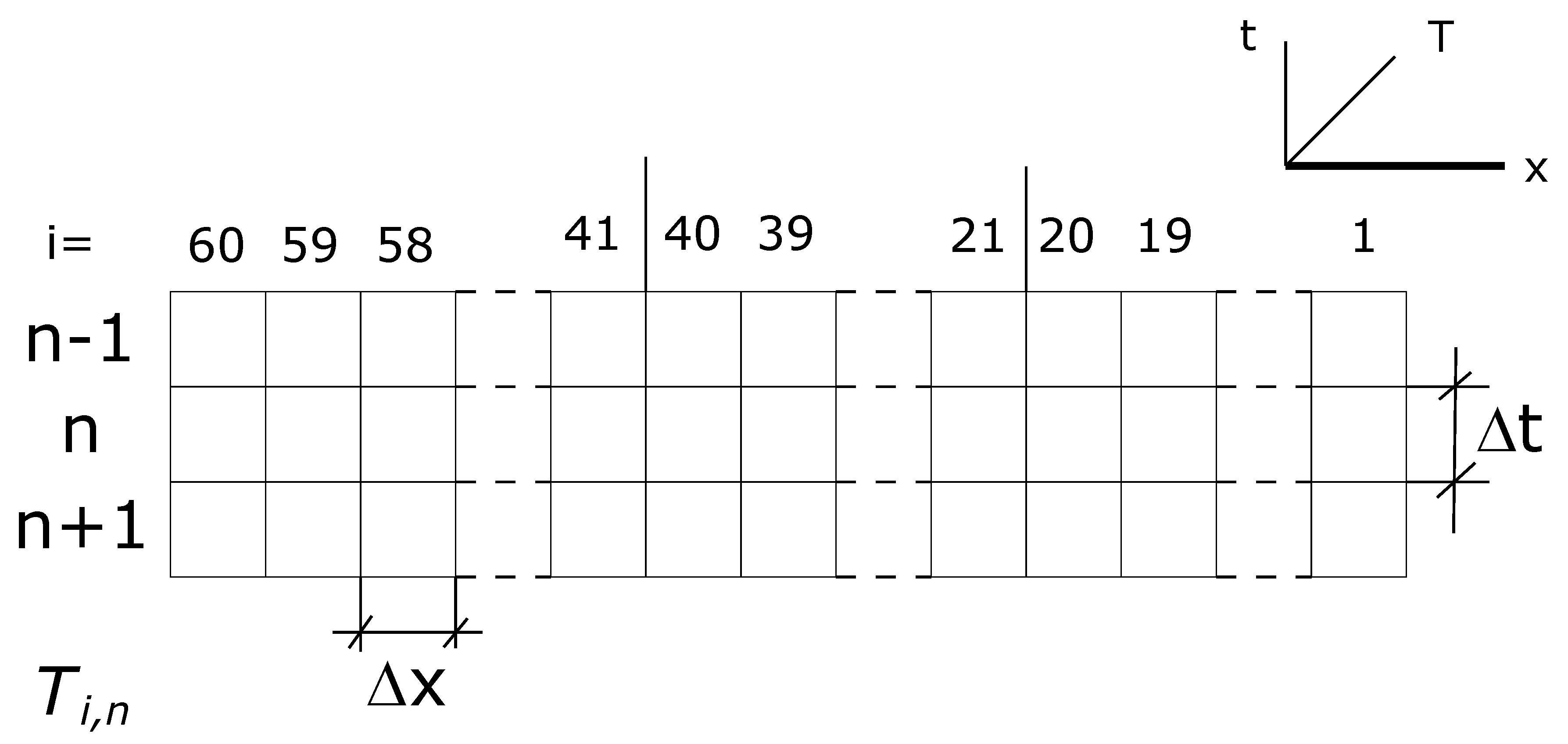
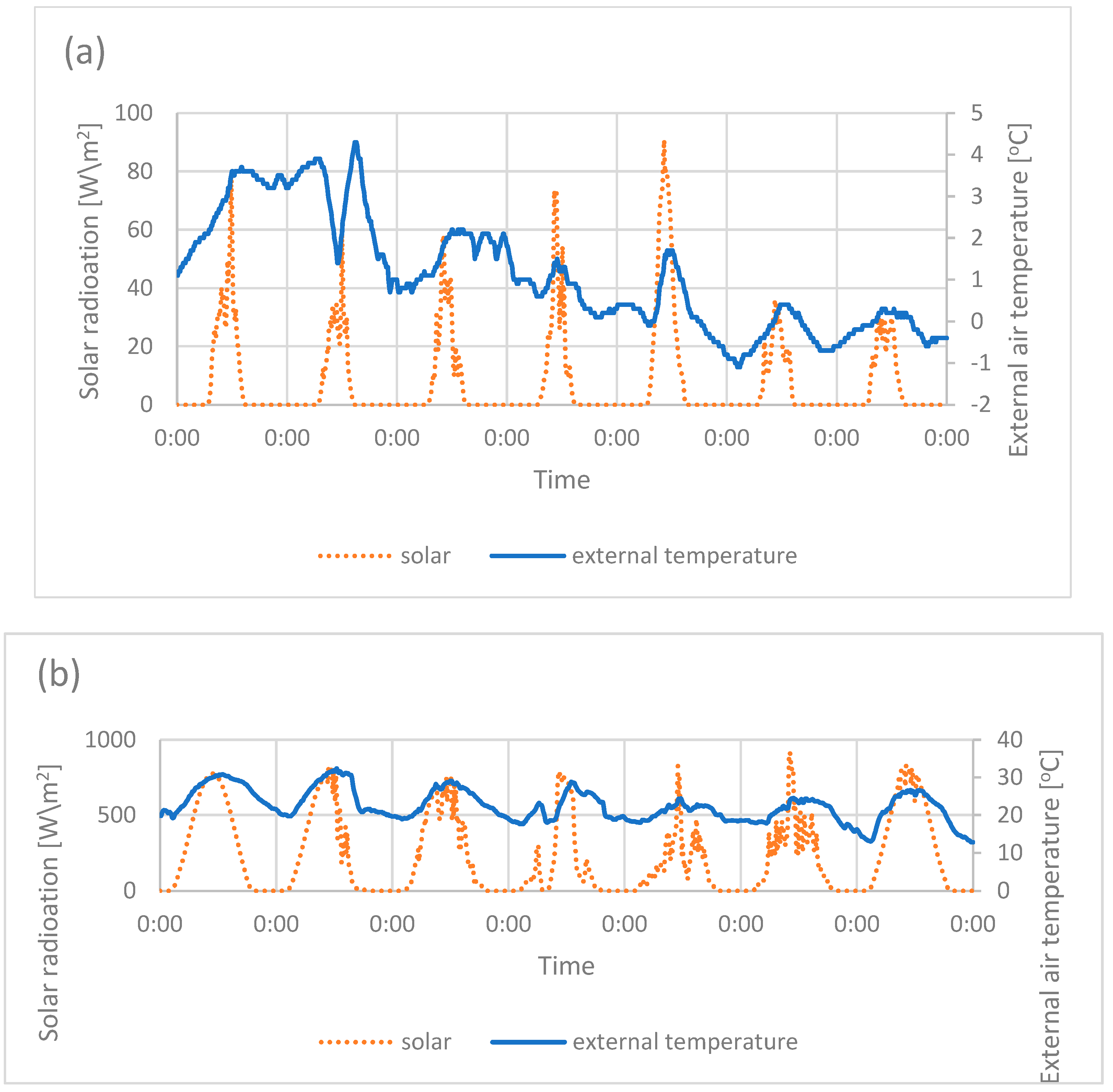
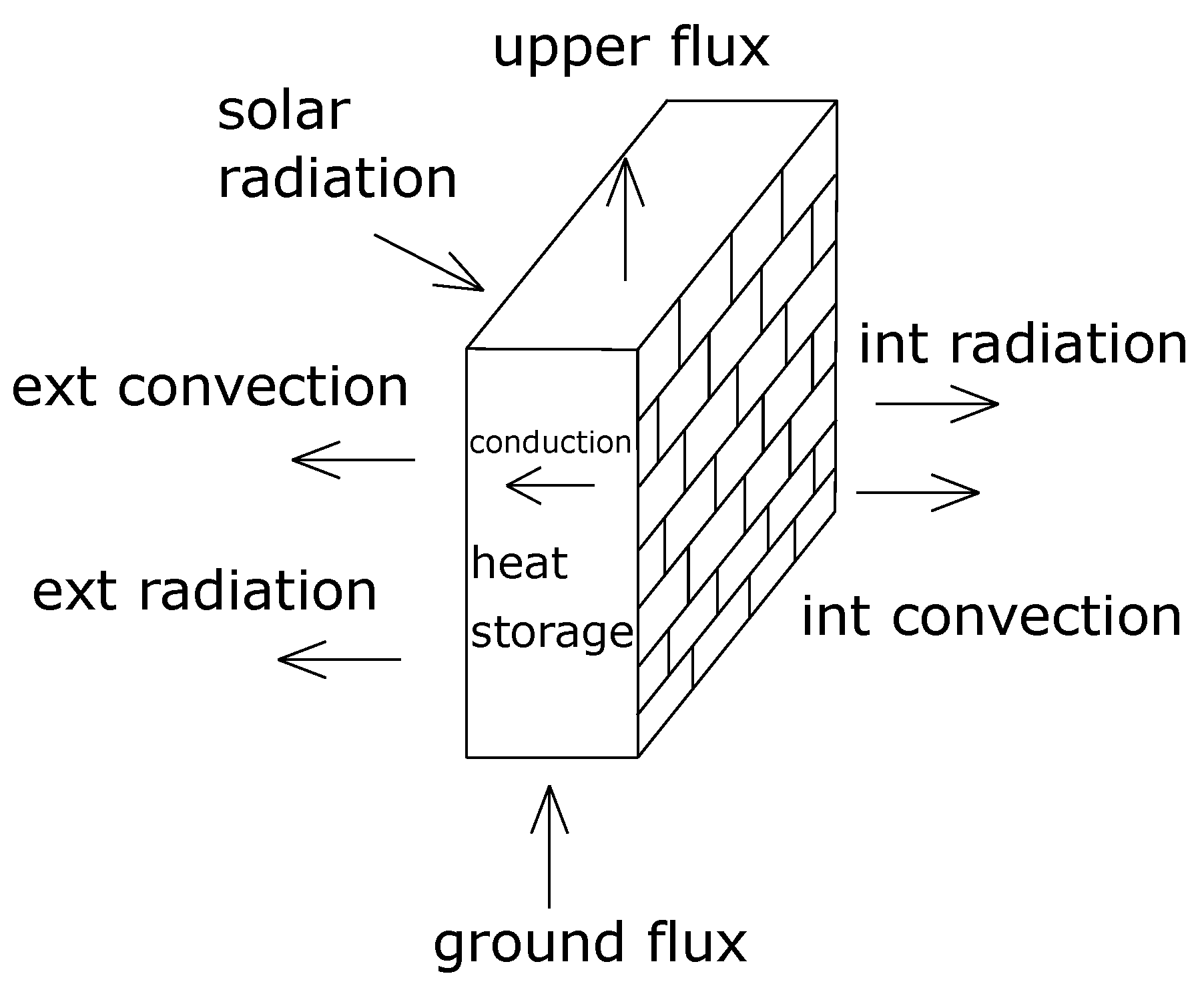
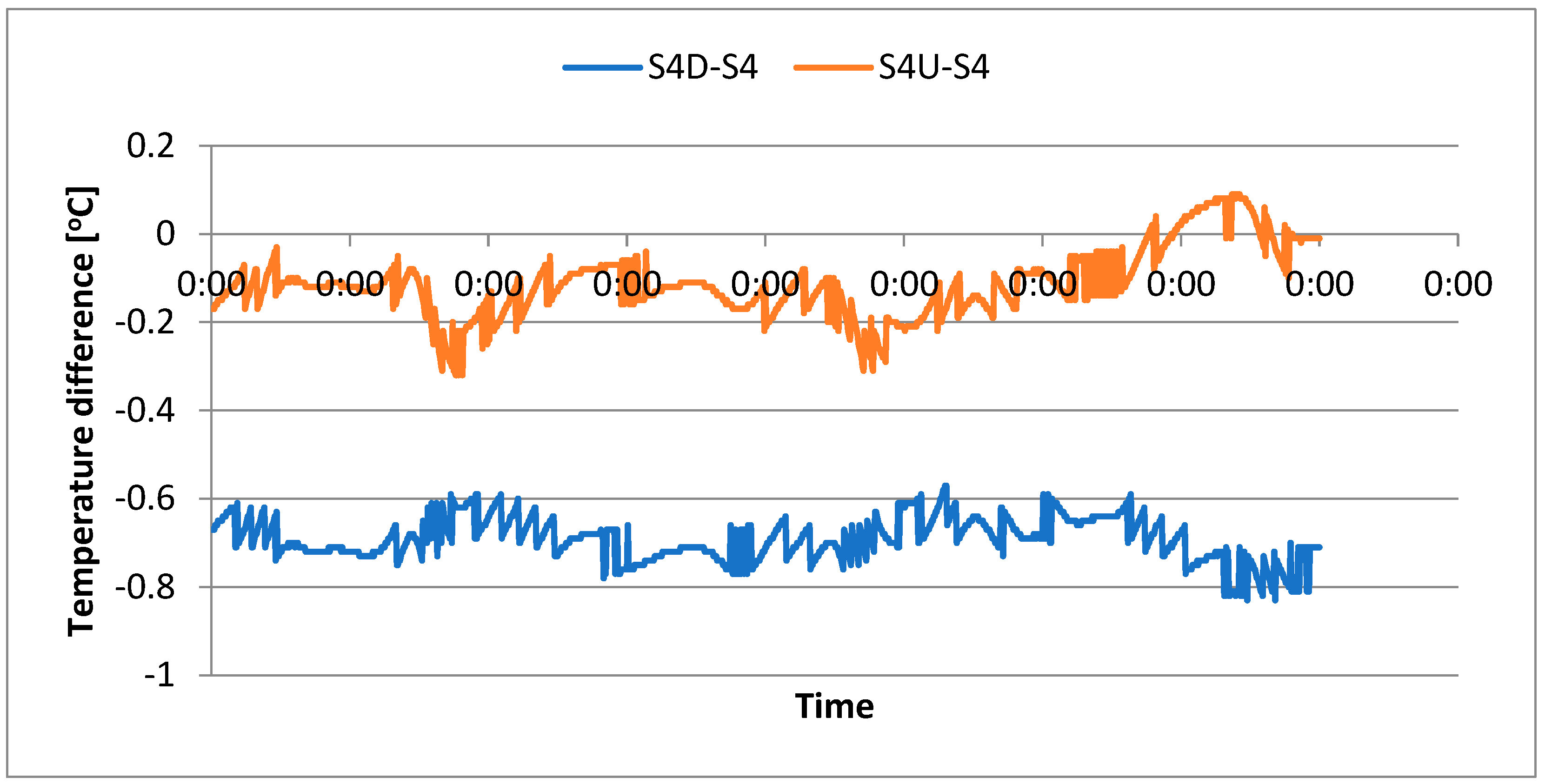
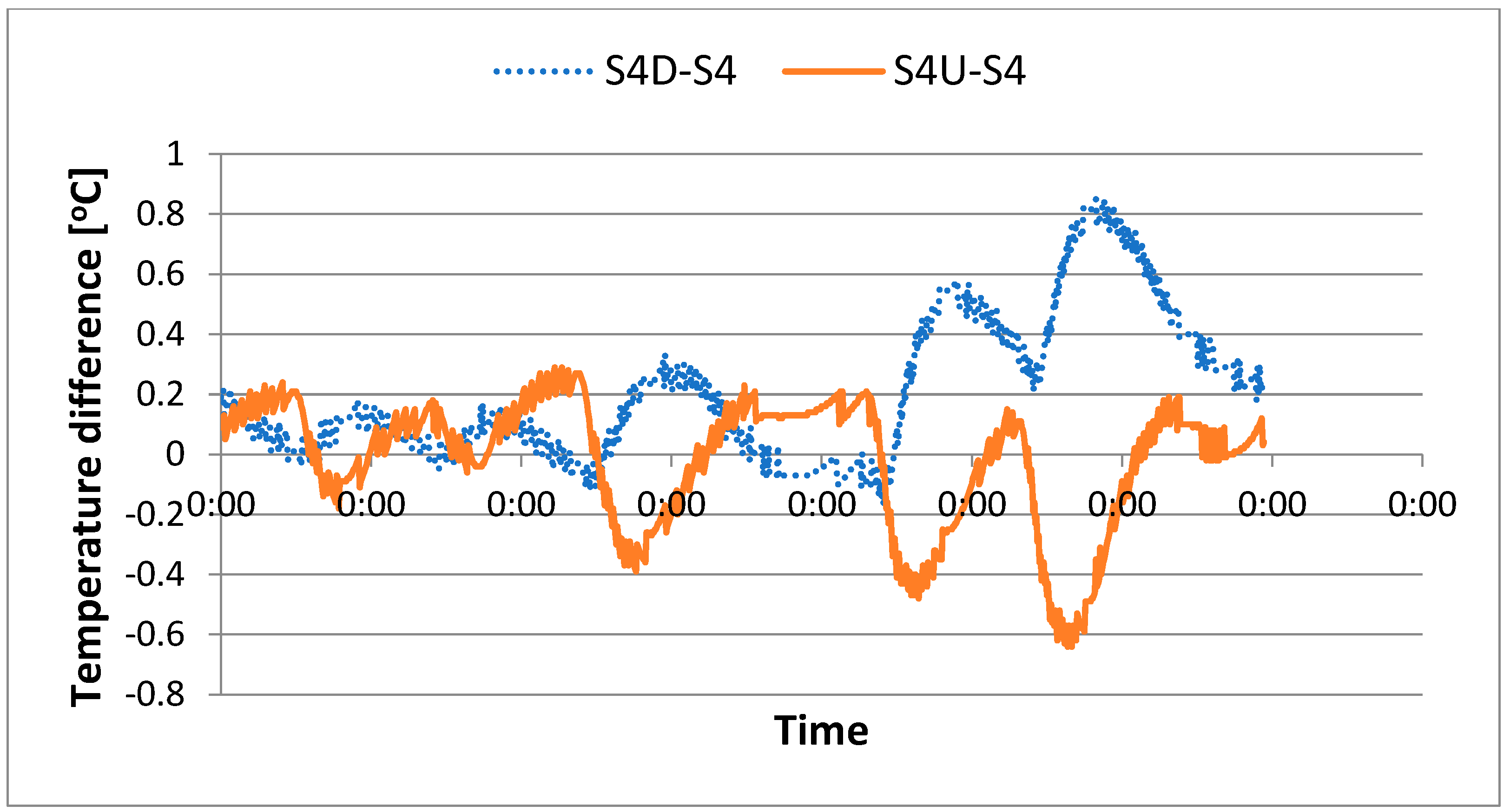
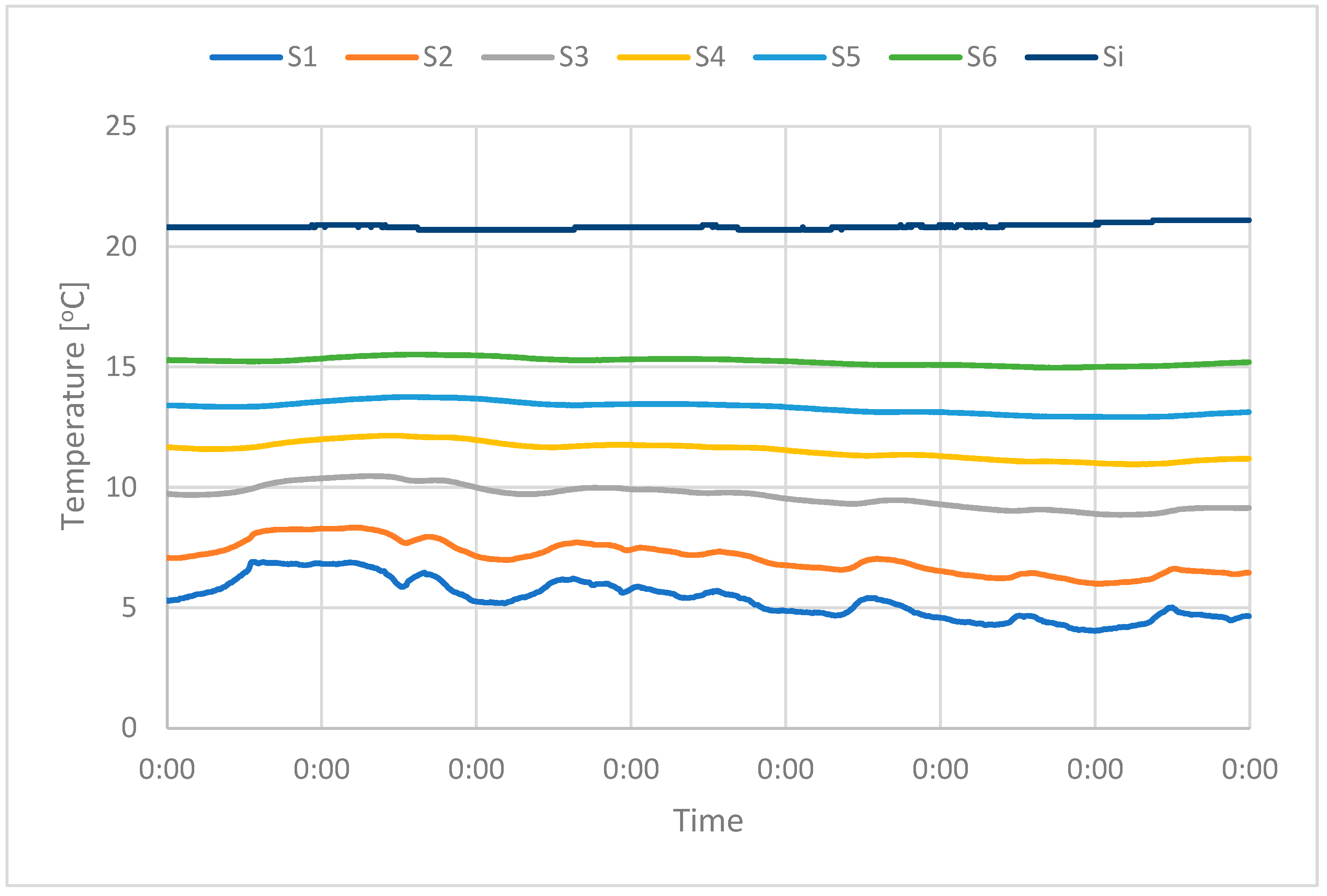
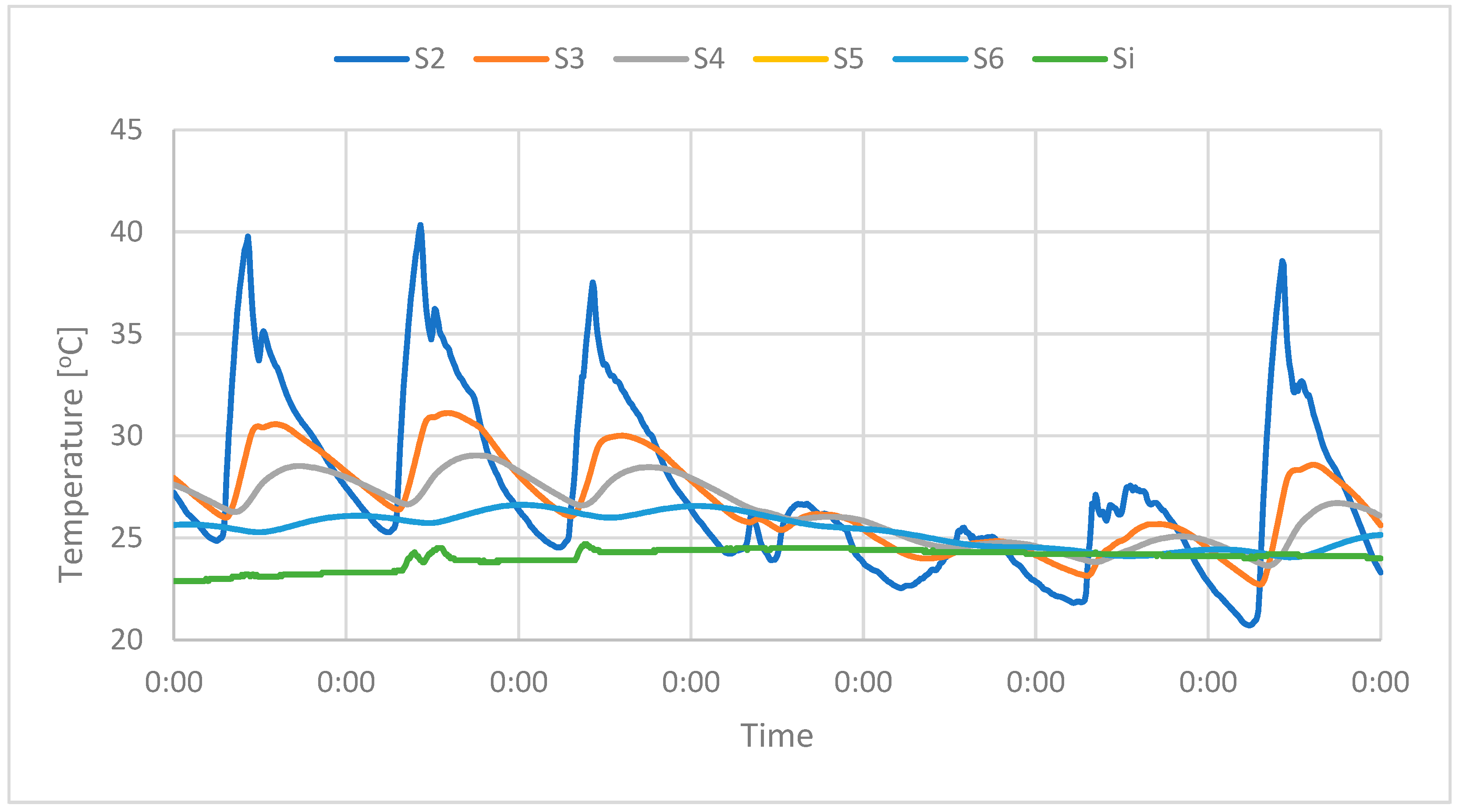

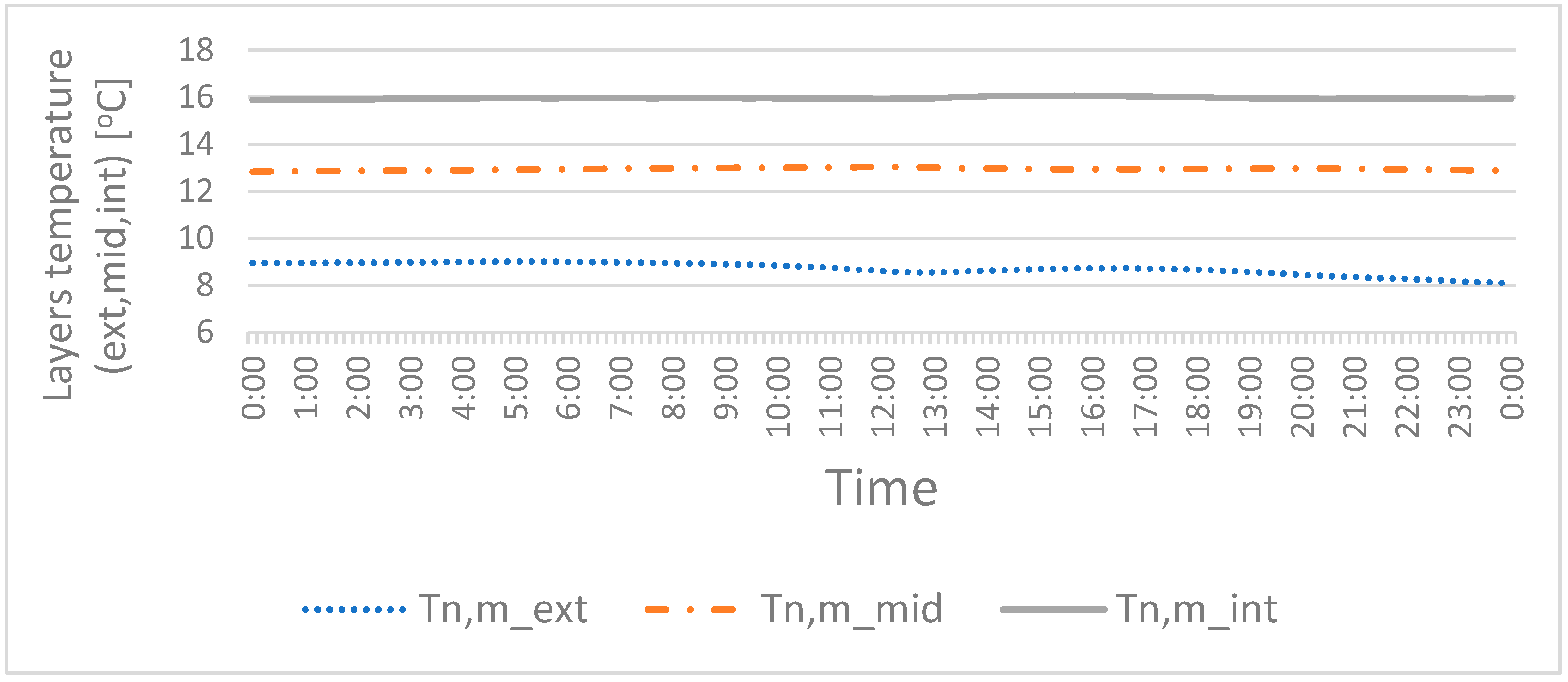
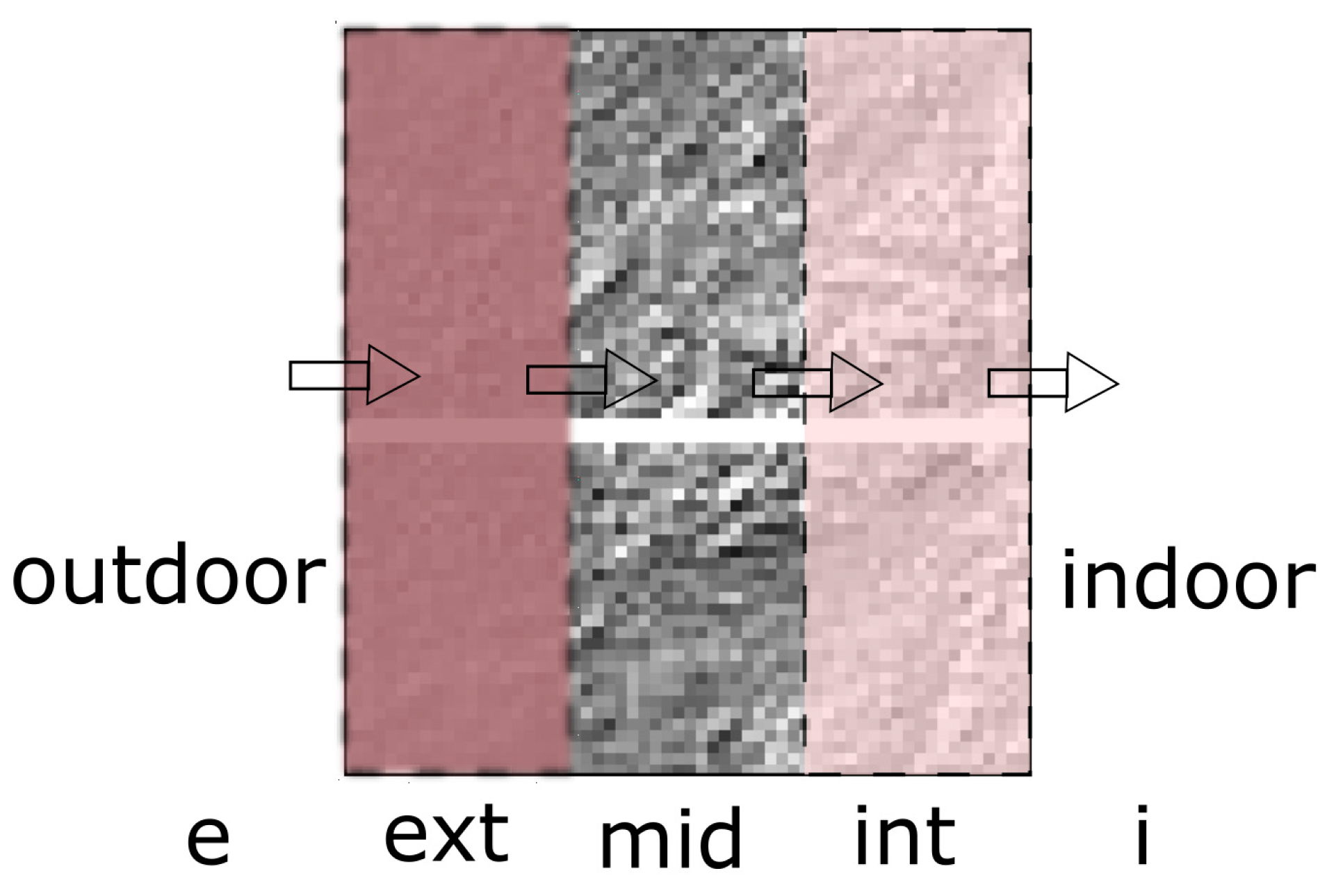

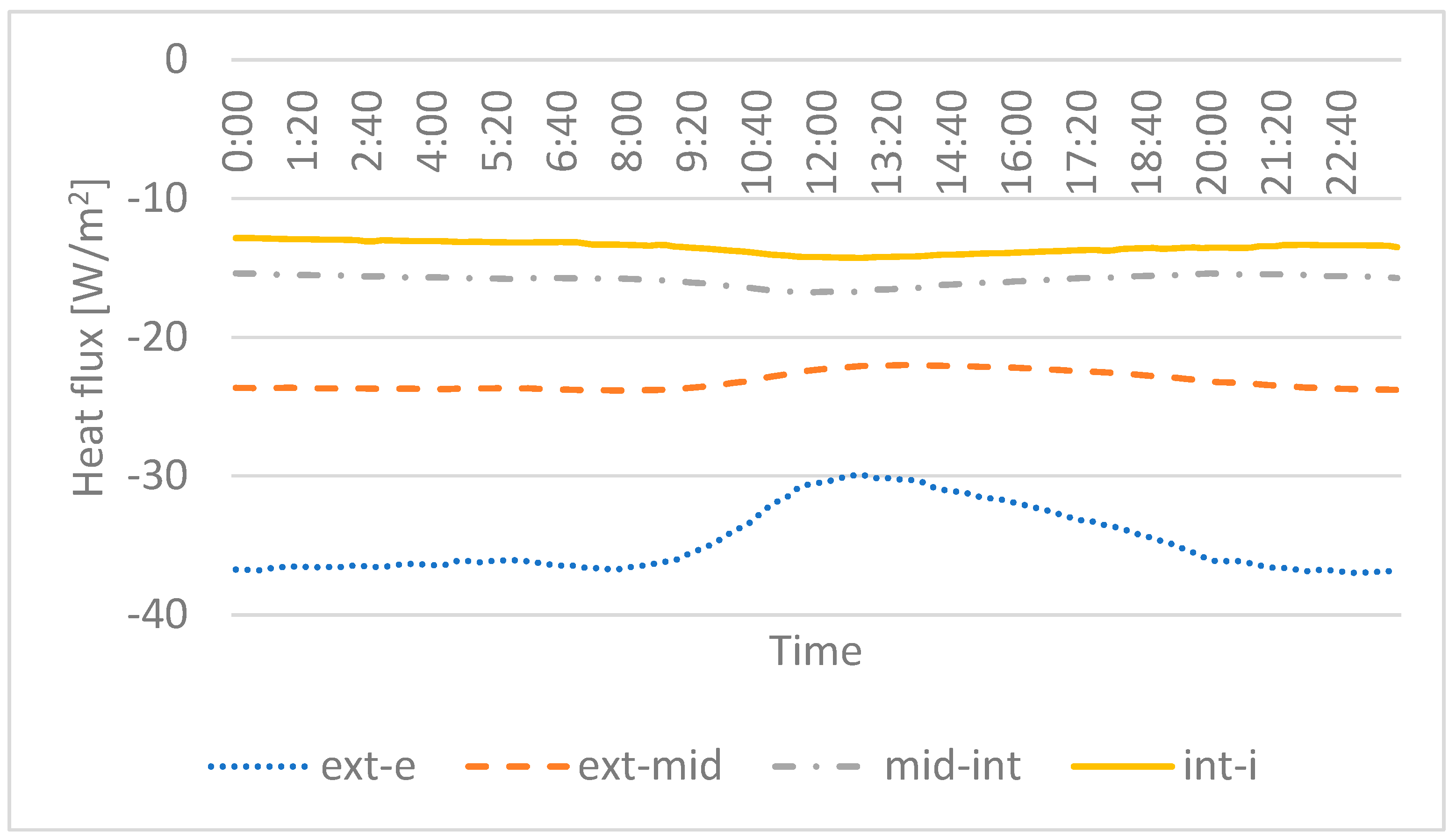
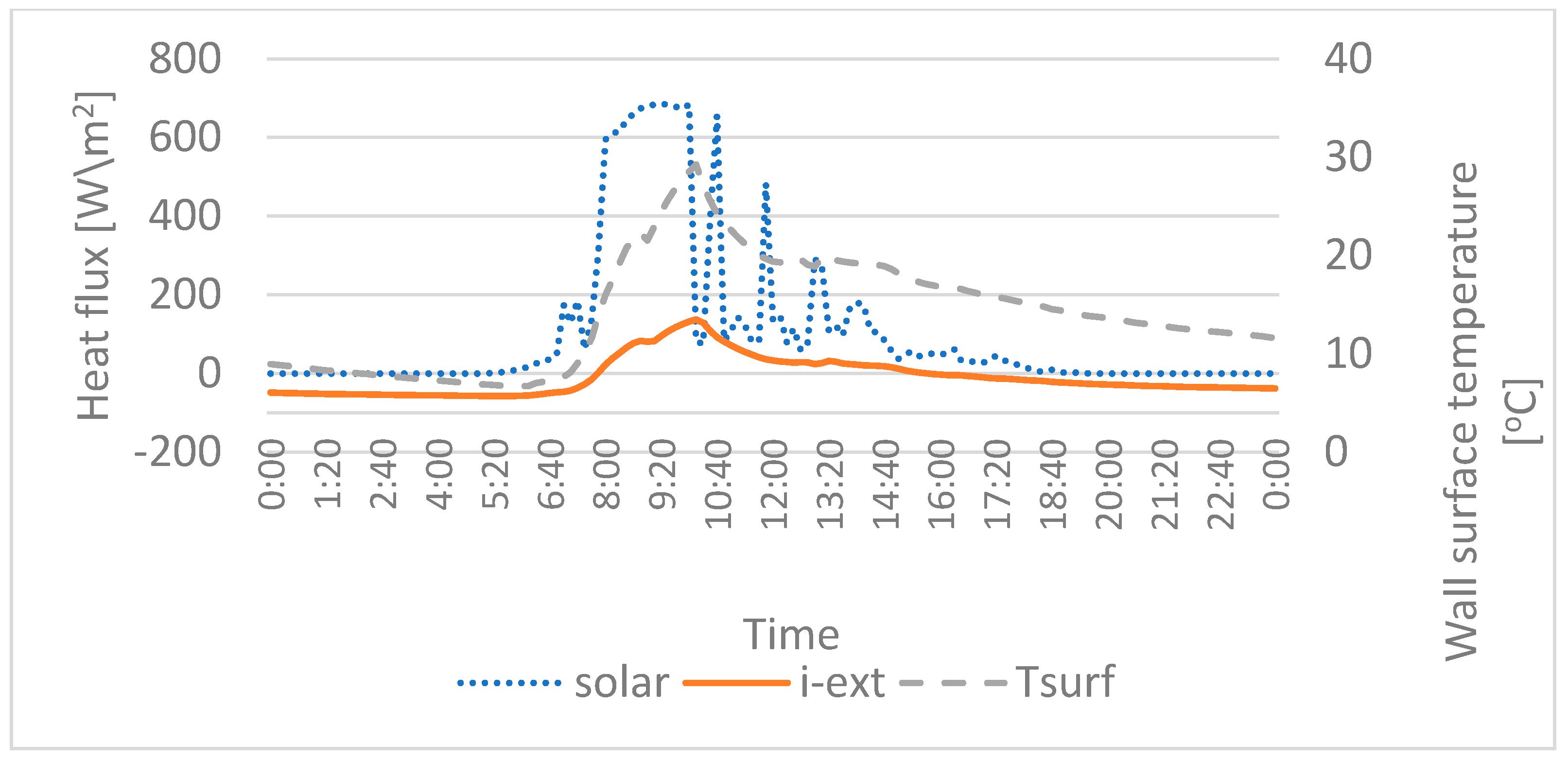
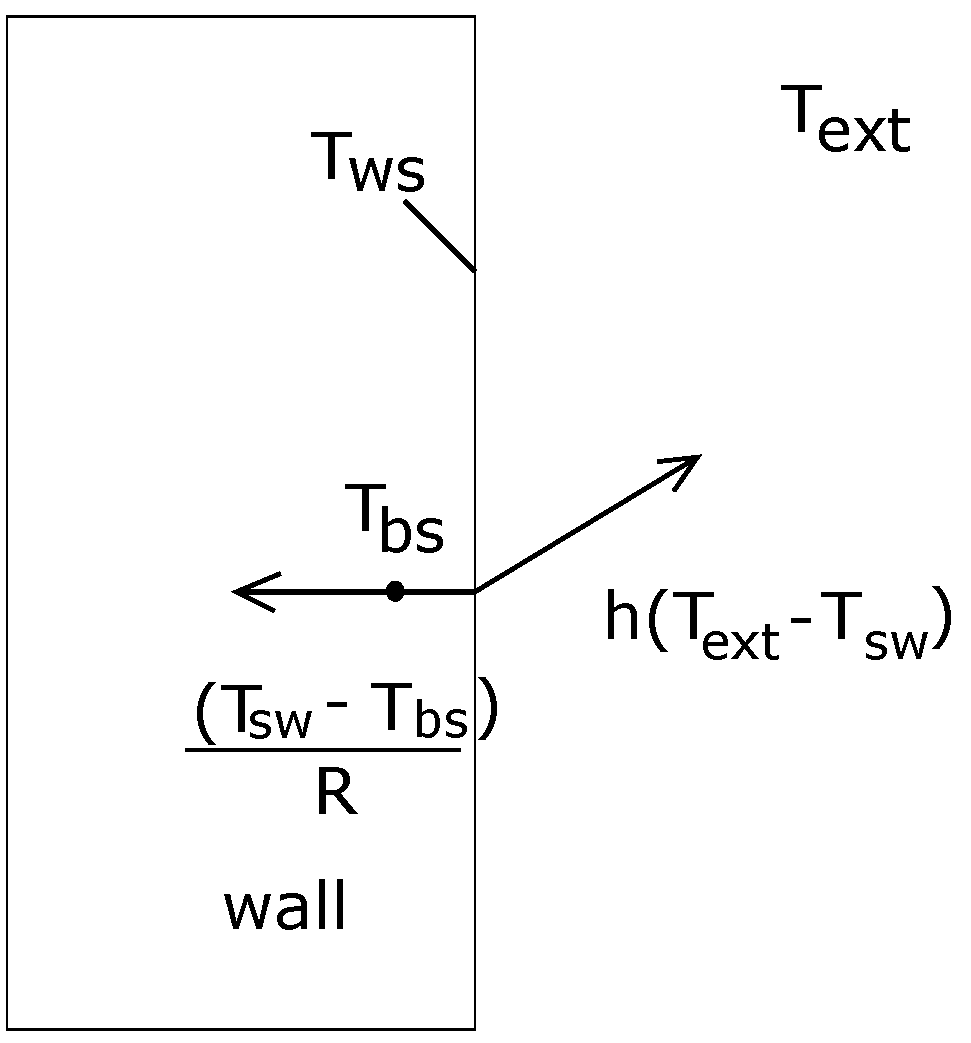

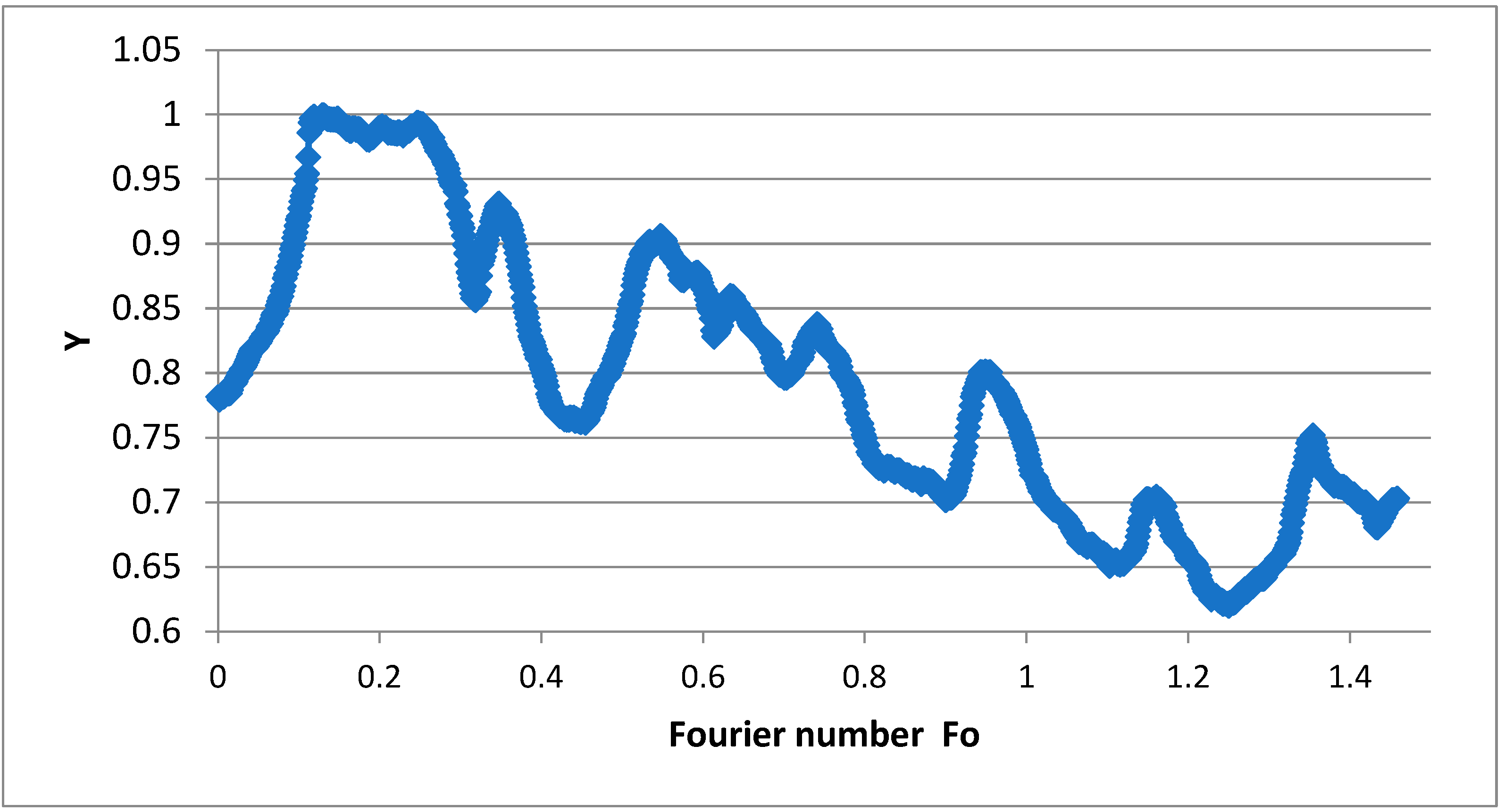
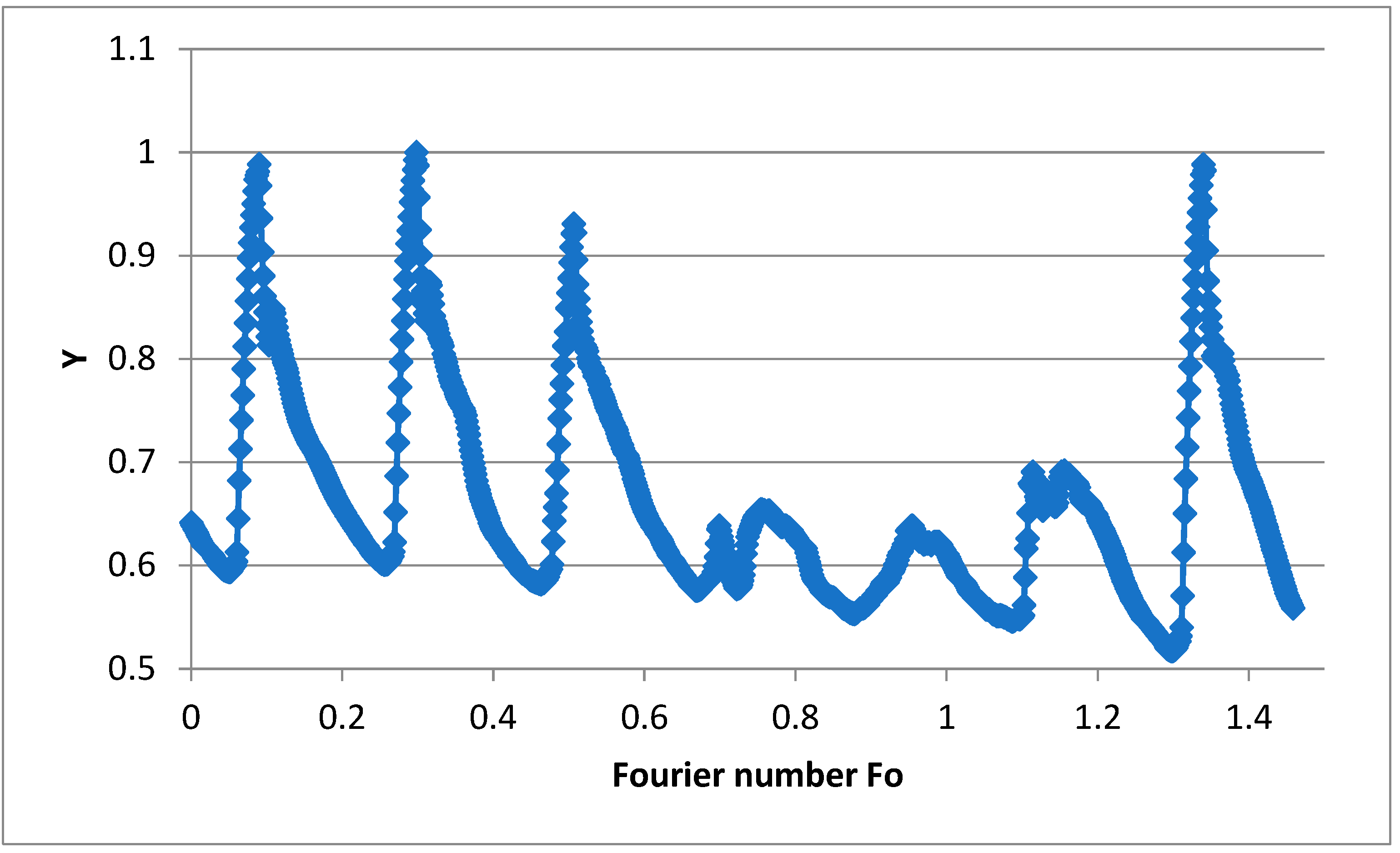
| Measurement No. | 1 | 2 | 3 | Mean |
|---|---|---|---|---|
| Thermal conductivity [W/(mK)] | 0.9948 | 1.0146 | 1.0166 | 1.01 |
| Volumetric specific heat [J/(m3K)] | 1.6703 × 106 | 1.6743 × 106 | 1.6754 × 106 | 1.6733 × 106 |
| Thermal diffusivity [m2/s] | 0.5956 × 10−6 | 0.6060 × 10−6 | 0.6068 × 10−6 | 0.6028 × 10−6 |
| Density [kg/m3] | 1412 | 1412 | 1412 | 1412 |
| Specific heat [J/(kgK)] | 1183 | 1186 | 1187 | 1185 |
| COD | 4–10 January | 21–27 June |
|---|---|---|
| R2 min | 0.9987 | 0.5627 |
| R2 max | 0.9997 | 0.9999 |
| R2 avg | 0.9992 | 0.9817 |
| Control Surface | i | j |
|---|---|---|
| ext-e | 60 | 59 |
| ext-mid | 41 | 40 |
| mid-int | 21 | 20 |
| int-i | 2 | 1 |
| Day | 21.06 | 22.06 | 23.06 | 24.06 | 25.06 | 26.06 | 27.06 |
|---|---|---|---|---|---|---|---|
| ΔTm_ext_mid | 5.23 | 5.25 | 4.31 | 2.15 | 1.09 | 2.38 | 6.25 |
| Estore [KJ/m2] | 3500 | 3514 | 2885 | 1439 | 730 | 1593 | 4183 |
| 4–10 January | 21–27 June | |
|---|---|---|
| T0 [oC] | 6.76 | 48.23 |
| Tf [oC] | −1.1 | 12.8 |
Publisher’s Note: MDPI stays neutral with regard to jurisdictional claims in published maps and institutional affiliations. |
© 2021 by the author. Licensee MDPI, Basel, Switzerland. This article is an open access article distributed under the terms and conditions of the Creative Commons Attribution (CC BY) license (https://creativecommons.org/licenses/by/4.0/).
Share and Cite
Owczarek, M. Thermal Fluxes and Solar Energy Storage in a Massive Brick Wall in Natural Conditions. Energies 2021, 14, 8093. https://doi.org/10.3390/en14238093
Owczarek M. Thermal Fluxes and Solar Energy Storage in a Massive Brick Wall in Natural Conditions. Energies. 2021; 14(23):8093. https://doi.org/10.3390/en14238093
Chicago/Turabian StyleOwczarek, Mariusz. 2021. "Thermal Fluxes and Solar Energy Storage in a Massive Brick Wall in Natural Conditions" Energies 14, no. 23: 8093. https://doi.org/10.3390/en14238093
APA StyleOwczarek, M. (2021). Thermal Fluxes and Solar Energy Storage in a Massive Brick Wall in Natural Conditions. Energies, 14(23), 8093. https://doi.org/10.3390/en14238093





